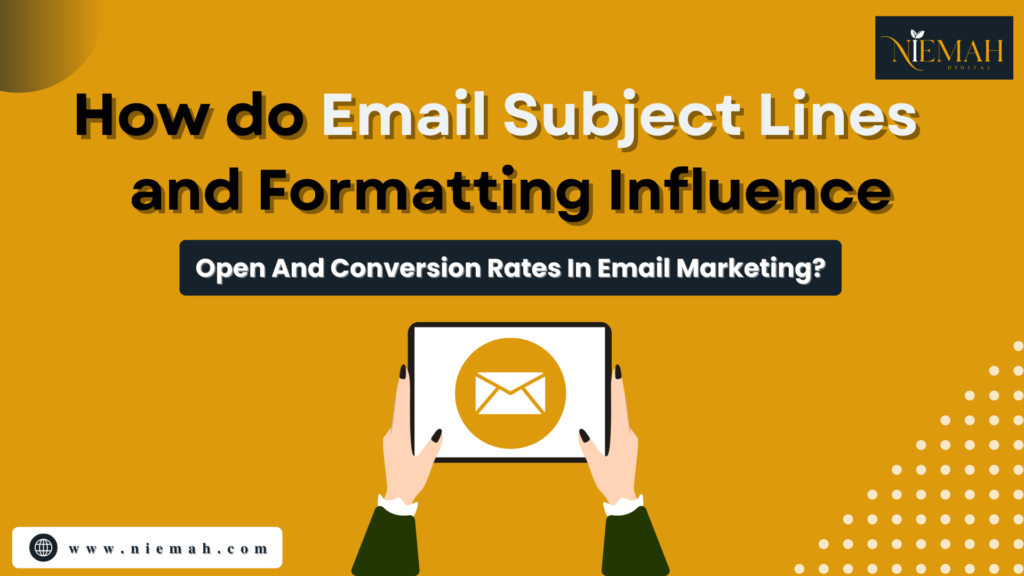
Email marketing remains one of the most powerful digital marketing strategies. However, its success heavily depends on two crucial factors: email subject lines and email formatting.
These elements significantly determine whether recipients open an email, engage with its content, and ultimately take the desired action.
Therefore, in this guest post, we will examine how email subject lines and formatting impact open rates and conversion rates. Additionally, we will discuss best practices to enhance the success of email marketing.
The Importance of Email Subject Lines in Open Rates:
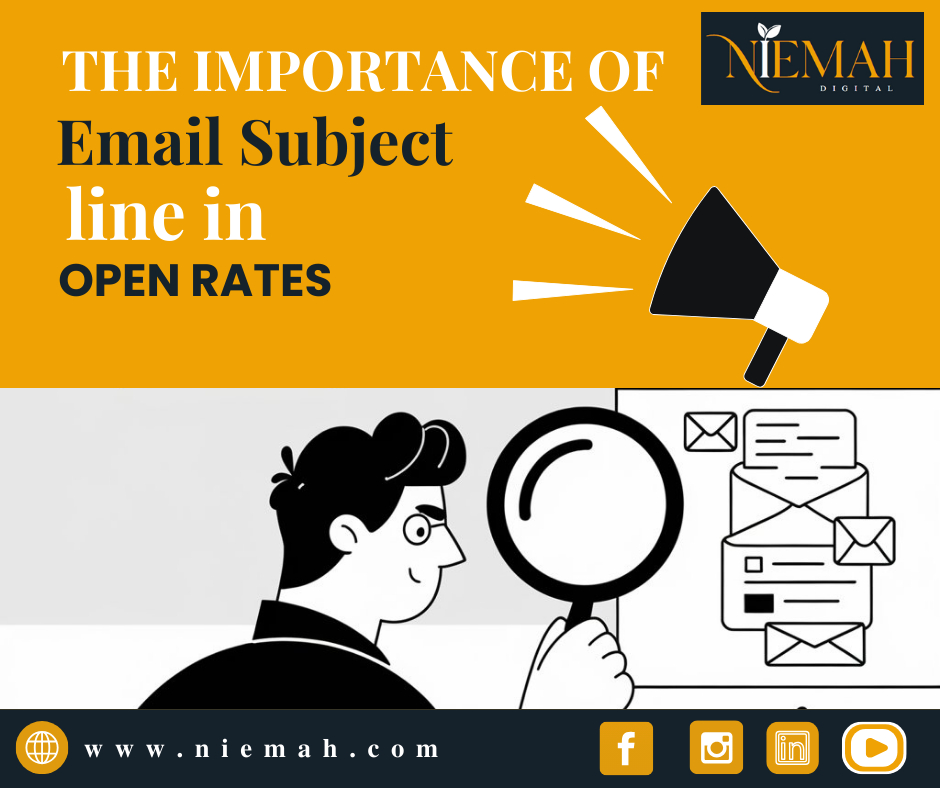
The email subject line is the first impression your audience gets. Therefore, if it fails to capture attention, your email may never be opened. Studies suggest that 47% of email recipients open an email based on the subject line alone, while 69% mark emails as spam just by reading the subject line.
To improve open rates, marketers should focus on clarity, relevance, and a compelling call to action that aligns with the email’s content.
Using power words, personalization, and urgency can significantly enhance engagement. For example, subject lines that include the recipient’s name or create curiosity tend to perform better. Furthermore, A/B testing different subject lines helps identify what resonates most with your audience. As a result, you can fine-tune your approach for maximum impact. Ultimately, an effective email subject line not only increases open rates but also sets the tone for a successful email marketing campaign.
The Subject Line: Your Email’s First and Strongest Hook
The success of an email campaign largely depends on the strength of its email subject lines. Indeed, a well-crafted subject line serves as the gateway to engagement, making it crucial to optimize for clarity, relevance, and appeal.
Whether you’re promoting a new product, sharing an update, or nurturing leads, an effective subject line can significantly improve open rates. Furthermore, marketers should experiment with various styles, such as using questions, lists, or power words, to determine what resonates most effectively with their audience.
Ultimately, a strong subject line can make the difference between an email that gets opened and one that gets ignored.
How to Craft the Best Email Subjects for Higher Open Rates
Creating the best email subjects requires a deep understanding of audience psychology and preferences. Indeed, subject lines should be concise yet compelling, providing a strong reason for the recipient to open the email.
Whether it’s incorporating urgency, curiosity, or exclusivity, a well-thought-out subject line can significantly impact open rates. To enhance results, follow these best practices for writing compelling email subject lines.
- Keep It Short and Concise: Subject lines under 50 characters tend to perform better.
- Use Personalization: Emails with the recipient’s first name in the subject line increase open rates by 26%.
- Incorporate urgency or Scarcity: words like “Limited Time,” “Exclusive,” or “Last Chance” encourage immediate action.
- Avoid spam triggers. Overuse of words like “free,” “buy now,” or “guaranteed” can send emails straight to the spam folder.
- Create Curiosity: Subject lines that pique interest without revealing everything entice users to open the email.
- A/B Testing: Experiment with different subject lines and analyze open rate performance.
A key objective of any email campaign is to increase email open rates. To achieve this, marketers must analyze what resonates most with their audience. By testing different styles, leveraging FOMO (Fear of Missing Out), and segmenting email lists based on behavior, they can optimize their strategy.
Examples of High-Performing Email Subject Lines:
- “Exclusive Offer Just for You—Open Now!”
- “You Won’t Believe This Deal—24 Hours Only!”
- “[First Name], Here’s Your Special Discount Inside!”
- “The Secret to Higher Sales? Open This Email”
- “Your Free Guide to Boosting Open Rates”
THE ROLE OF EMAIL FORMATTING IN CONVERSION RATES
Even if an email is opened, poor formatting can lead to low engagement and conversions. Therefore, a well-structured email ensures readability, maintains interest, and guides recipients toward the CTA (Call to Action). In addition, an effective email formatting guide provides essential techniques to create visually appealing and user-friendly emails.
Moreover, a well-structured email formatting guide ensures that emails are visually appealing and easy to navigate. For instance, proper spacing, clear fonts, and mobile responsiveness play a critical role in maintaining reader interest. Without good formatting, even the most well-crafted email subject line won’t be enough to drive conversions.
Best Practices for Effective Email Formatting:
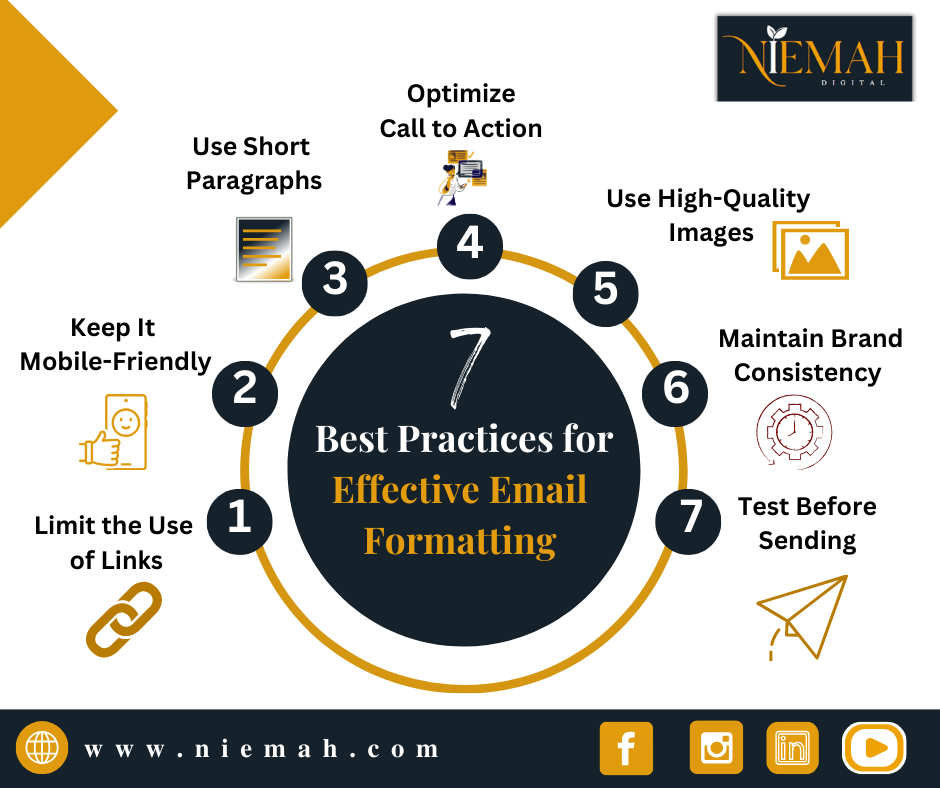
- Keep It Mobile-Friendly 85% of users access emails on mobile devices. Ensure emails are responsive and easy to read on small screens.
- Use Short Paragraphs: Avoid large blocks of text; instead, use concise paragraphs and bullet points.
- Optimize Call to Action (CTA): CTAs should be clear, visible, and action-driven (e.g., “Get Your Discount Now”).
- Use High-Quality Images: Emails with relevant images improve engagement, but ensure they are optimized for fast loading.
- Maintain brand consistency: Use a consistent color scheme, font, and logo to build brand recognition.
- Limit the Use of Links: Too many links can trigger spam filters and distract users.
- Test Before Sending – Always preview emails on different devices and email clients to ensure proper formatting.
Example of a Well-Formatted Email Structure:
Subject: “Your Exclusive Discount Awaits!”
Header: “Limited-Time Offer Just for You!”
Body:
- Personal greeting (Hi [First Name],)
- Brief introduction to the offer
- Bullet points highlighting key benefits
- High-quality image or product showcase
- Clear CTA button (“Claim Your Offer”)
Footer:
- Social media links
- Unsubscribe option
- Contact details
How Email Subject Lines and Formatting Work Together for Maximum Impact
Both email subject lines and email formatting contribute to overall email marketing success. Specifically, the subject line’s job is to capture attention and encourage opens, while the formatting ensures engagement and conversions.
Moreover, a combination of engaging email subject lines and well-structured formatting leads to a higher email open rate, which is critical for achieving marketing goals.
Key Takeaways:
- A compelling subject line increases open rates.
- Well-structured email formatting enhances readability and drives conversions.
- Personalization, urgency, and curiosity in subject lines improve performance.
- Mobile-optimized and visually appealing emails keep readers engaged.
- Clear CTAs and minimal distractions lead to higher conversion rates.
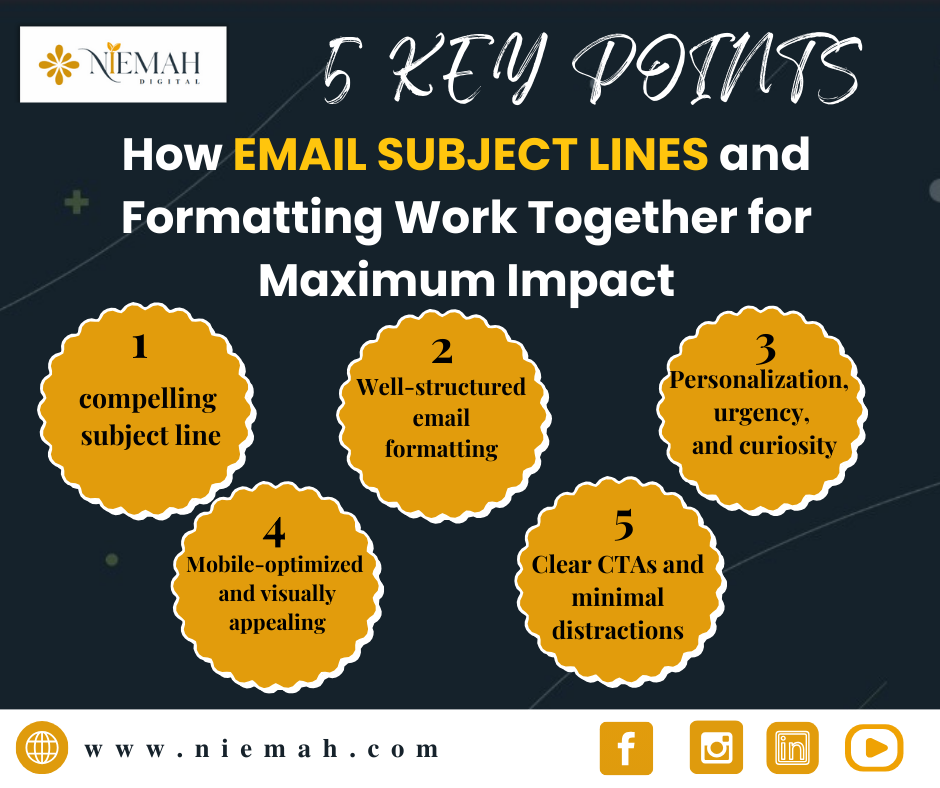
CONCLUSION
Both email subject lines and email formatting play a crucial role in determining the success of an email marketing campaign. In fact, a compelling subject line captures the recipient’s attention and encourages them to open the email. Meanwhile, proper formatting ensures readability and drives conversions.
Moreover, by following best practices—such as using personalization, optimizing for mobile, and crafting clear CTAs—marketers can significantly increase email open rates and improve engagement. As a result, these strategies lead to better campaign performance and stronger connections with the audience.
By applying these strategies, businesses can significantly improve email marketing performance, resulting in better engagement, higher open rates, and increased conversions. Ultimately, implementing these email marketing tips will help marketers refine their strategies and achieve better campaign results.
“Join Successful Brands Maximizing Their Email Marketing ROI!”
Let’s Grow Your Business Together
FAQS
1. Why are email subject lines important in email marketing?
Email subject lines are the first impression of your email. A compelling subject line increases open rates, improves engagement, and prevents emails from being ignored or marked as spam.
Example: A subject line like “Exclusive 50% Off – Limited Time!” is more engaging than “Big Sale Happening.” Learn more about effective email marketing
2. How can I write the best email subject lines to increase open rates?
To craft high-performing email subject lines, keep them short, use personalization, create urgency, avoid spam-trigger words, and test different variations through A/B testing.
Example: “John, Your Special Discount Expires Today!” performs better than “Get Your Discount.” Check out our services to optimize your marketing strategy
03. How does email formatting impact conversion rates?
Proper email formatting ensures readability, improves user experience, and guides recipients toward your call to action (CTA). A well-structured email increases engagement and conversions.
Example: Emails with a clear CTA like “Shop Now” vs. a lengthy paragraph of text perform significantly better.
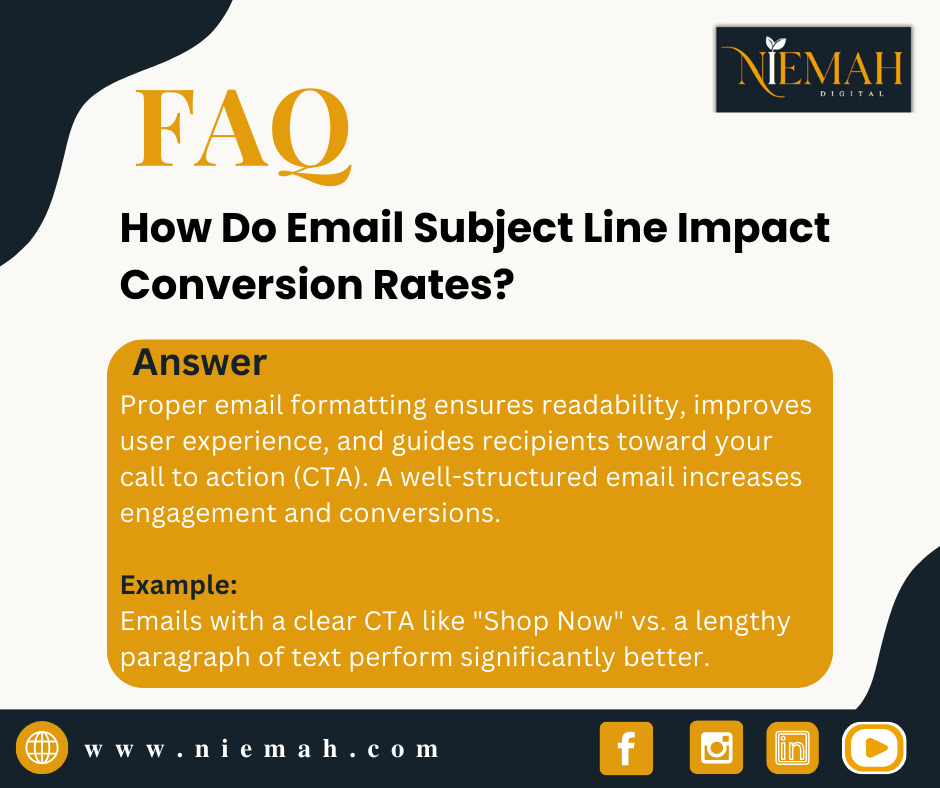
4. What are some best practices for email formatting?
Effective email formatting includes using short paragraphs, bullet points, mobile-friendly designs, high-quality images, clear CTAs, and consistent branding to enhance readability and engagement.
Example: A well-formatted email:
- Header: “Your Exclusive Offer Inside”
- Body: Short, concise message with an image
- CTA: “Claim Your Offer Now!”
5. How can I increase my email open rates?
To boost open rates, optimize subject lines, personalize emails, maintain a clean email list, send emails at optimal times, and avoid spam-triggering content.
Example: Send an email on Tuesday at 10 AM with “Hurry! Your 20% Discount Ends Today!” rather than sending it on a weekend when engagement is low. Learn more about us
6. What role does mobile optimization play in email marketing?
Since most users open emails on mobile devices, a mobile-responsive design ensures easy readability, better engagement, and higher conversions.
Example: A mobile-optimized email will have a single-column format, large buttons, and easy-to-read text.
7. How many words should an email subject line have?
The ideal subject line length is between 6 to 10 words or 30 to 50 characters to ensure visibility on all devices, especially mobile screens.
Example: “Limited Time! 40% Off All Items” (concise and compelling) vs “We Have an Amazing Sale Going on Right Now with Discounts for Everyone” (too long).
8. Can emojis in email subject lines increase open rates?
Yes, when used appropriately, emojis can grab attention and improve open rates. However, excessive use can make emails look unprofessional or trigger spam filters.
Example: “🌟 Don’t Miss Out on This Flash Sale!” vs “Flash Sale Today!” (emoji adds visual appeal).
9. How does A/B testing help improve email subject lines?
A/B testing allows you to compare different subject lines to see which performs best, helping you refine your strategy for higher open rates and engagement.
Example: Testing “Exclusive Deal Just for You” vs “Your Special Discount Inside” to see which gets more opens.
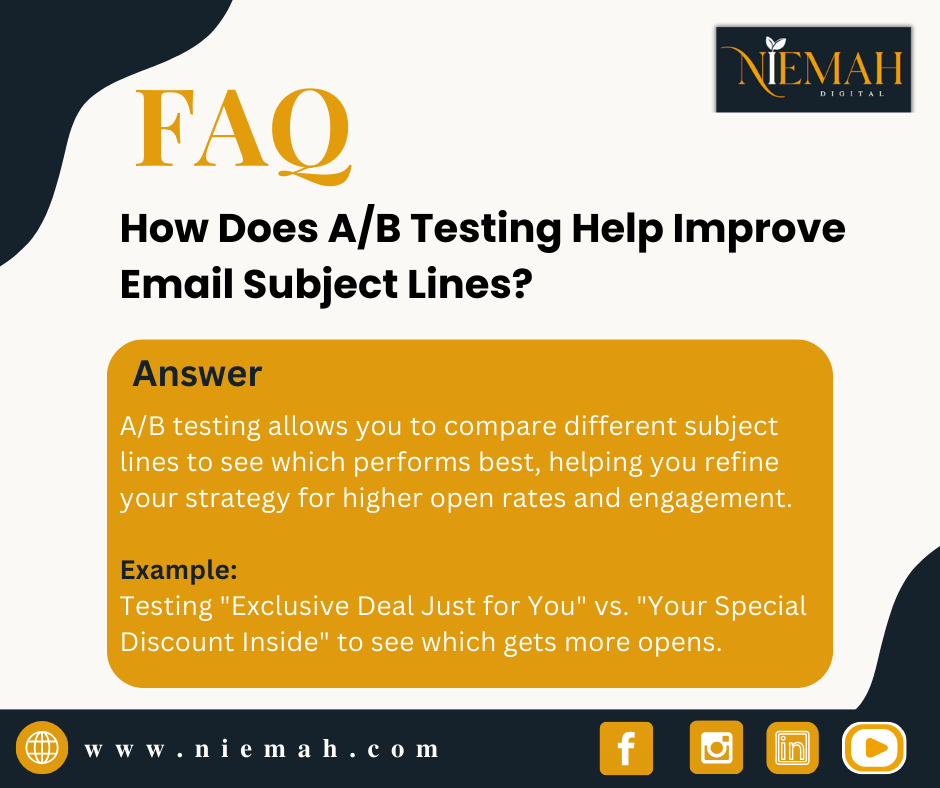
10. What are the common mistakes that hurt email marketing performance?
Common mistakes include using generic subject lines, ignoring personalization, poor formatting, lack of mobile optimization, and overwhelming emails with too many links or images.
Example: A poorly designed email with multiple CTAs, long paragraphs, and no clear message will have a lower engagement rate than a simple, structured email with a single CTA like “Start Your Free Trial Now.”For more expert tips and guidance, visit our website.

